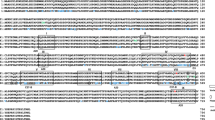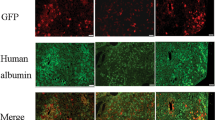Abstract
As the adeno-associated virus (AAV) vectors hold unique advantages over other viral vectors, AAV gene therapy has accumulated rapid progress and development. Liver-targeted gene therapy by AAV vectors has been successfully applied in clinical trials for many diseases. Low transduction efficiency and high prevalence of neutralizing antibodies (Nabs), however, are the major obstacles to further translate this therapeutic strategy into clinical trials. Pre-clinical evaluation on hepatocytes could help to elucidate the tropism of AAV serotypes for liver-targeted gene therapy, and could also provide a test model to develop novel AAV mutants with Nabs evasion and high liver tropism. Here, we described the basic laboratory procedure to apply the AAV vector to transduce human hepatocytes in vitro and in vivo with some tips gained from our own experience.
Access this chapter
Tax calculation will be finalised at checkout
Purchases are for personal use only
Similar content being viewed by others
References
Sobrevals L et al (2012) AAV vectors transduce hepatocytes in vivo as efficiently in cirrhotic as in healthy rat livers. Gene Ther 19(4):411–417
Baruteau J et al (2017) Gene therapy for monogenic liver diseases: clinical successes, current challenges and future prospects. J Inherit Metab Dis 40(4):497–517
Kattenhorn LM et al (2016) Adeno-associated virus gene therapy for liver disease. Hum Gene Ther 27(12):947–961
George LA et al (2020) Long-term follow-up of the first in human intravascular delivery of AAV for gene transfer: AAV2-hFIX16 for severe hemophilia B. Mol Ther 28(9):2073–2082
Leng Y et al (2019) Long-term correction of copper metabolism in Wilson’s disease mice with AAV8 vector delivering truncated ATP7B. Hum Gene Ther 30(12):1494–1504
Tao R et al (2020) Long-term metabolic correction of phenylketonuria by AAV-delivered phenylalanine amino lyase. Mol Ther Methods Clin Dev 19:507–517
De Sabbata G et al (2021) Long-term correction of ornithine transcarbamylase deficiency in Spf-Ash mice with a translationally optimized AAV vector. Mol Ther Methods Clin Dev 20:169–180
Cabanes-Creus M et al (2020) Restoring the natural tropism of AAV2 vectors for human liver. Sci Transl Med 12(560):eaba3312
Qian R et al (2021) Directed evolution of AAV serotype 5 for increased hepatocyte transduction and retained low humoral seroreactivity. Mol Ther Methods Clin Dev 20:122–132
Havlik LP et al (2020) Coevolution of adeno-associated virus capsid antigenicity and tropism through a structure-guided approach. J Virol 94(19):e00976–e00920
Wang L et al (2015) Comparative study of liver gene transfer with AAV vectors based on natural and engineered AAV capsids. Mol Ther 23(12):1877–1887
Tanimizu N, Miyajima A (2007) Molecular mechanism of liver development and regeneration. Int Rev Cytol 259:1–48
Zhou Z, Xu MJ, Gao B (2016) Hepatocytes: a key cell type for innate immunity. Cell Mol Immunol 13(3):301–315
Zhang K et al (2018) In vitro expansion of primary human hepatocytes with efficient liver rpopulation capacity. Cell Stem Cell 23(6):806–819 e4
Zeilinger K et al (2016) Cell sources for in vitro human liver cell culture models. Exp Biol Med (Maywood) 241(15):1684–1698
Foquet L et al (2017) Successful engraftment of human hepatocytes in uPA-SCID and FRG((R)) KO mice. Methods Mol Biol 1506:117–130
Strom SC, Davila J, Grompe M (2010) Chimeric mice with humanized liver: tools for the study of drug metabolism, excretion, and toxicity. Methods Mol Biol 640:491–509
Zou CH et al (2020) Experimental variables that affect human hepatocyte MV transduction in liver chimeric mice. Mol Ther Methods Clin Dev 18:189–198
Lisowski L et al (2014) Selection and evaluation of clinically relevant AAV variants in a xenograft liver model. Nature 506(7488):382–386
Davidoff AM et al (2005) Comparison of the ability of adeno-associated viral vectors pseudotyped with serotype 2, 5, and 8 capsid proteins to mediate efficient transduction of the liver in murine and nonhuman primate models. Mol Ther 11(6):875–888
Bissig-Choisat B et al (2015) Development and rescue of human familial hypercholesterolaemia in a xenograft mouse model. Nat Commun 6:7339
Ling C et al (2020) Transduction of primary human hepatocytes in vitro and in humanized murine livers in vivo by recombinant AAV3 vectors. Mol Ther 22:S2–S2
Yang H et al (2020) Enhanced transduction of human hematopoietic stem cells by AAV6 vectors: implications in gene therapy and genome editing. Mol Ther Nucleic Acids 20:451–458
Batty P, Lillicrap D (2021) Hemophilia gene therapy: approaching the first licensed product. Hemasphere 5(3):e540
Pipe S et al (2019) Clinical considerations for capsid choice in the development of liver-targeted AAV-based gene transfer. Mol Ther Methods Clin Dev 15:170–178
George LA et al (2017) Hemophilia B gene therapy with a high-specific-activity factor IX variant. New England J Med 377(23):2215–2227
Li SY et al (2015) Efficient and targeted transduction of nonhuman primate liver with systemically delivered optimized AAV3B vectors. Mol Ther 23(12):1867–1876
Paulk NK et al (2018) Bioengineered AAV capsids with combined high human liver transduction in vivo and unique humoral seroreactivity. Mol Ther 26(1):289–303
Pei X et al (2020) Development of AAV variants with human hepatocyte tropism and neutralizing antibody escape capacity. Mol Ther Methods Clin Dev 18:259–268
Shao W et al (2019) Superior human hepatocyte transduction with adeno-associated virus vector serotype 7. Gene Ther 26(12):504–514
Grieger JC, Choi VW, Samulski RJ (2006) Production and characterization of adeno-associated viral vectors. Nat Protoc 1(3):1412–1428
Xiao X, Li J, Samulski RJ (1998) Production of high-titer recombinant adeno-associated virus vectors in the absence of helper adenovirus. J Virol 72(3):2224–2232
Gao G et al (2000) Purification of recombinant adeno-associated virus vectors by column chromatography and its performance in vivo. Hum Gene Ther 11(15):2079–2091
Kohlbrenner E, Weber T (2017) Production and characterization of vectors based on the cardiotropic AAV serotype 9. Methods Mol Biol 1521:91–107
Nudel BC et al (1989) Stability of Escherichia coli strains harboring recombinant plasmids for L-threonine production. Antonie Van Leeuwenhoek 56(3):273–282
Azuma H et al (2007) Robust expansion of human hepatocytes in Fah-/-/Rag2-/-/Il2rg-/- mice. Nat Biotechnol 25(8):903–910
Bissig KD et al (2007) Repopulation of adult and neonatal mice with human hepatocytes: a chimeric animal model. Proc Natl Acad Sci U S A 104(51):20507–20511
Adigbli G et al (2020) Humanization of immunodeficient animals for the modeling of transplantation, graft versus host disease, and regenerative medicine. Transplantation 104(11):2290–2306
Durost PA (2018) Gene therapy with an adeno-associated viral vector expressing human interleukin-2 alters immune system homeostasis in humanized mice. Hum Gene Ther 29(3):352–365
Gorantla S et al (2007) Human immunodeficiency virus type 1 pathobiology studied in humanized BALB/c-Rag2-/-gammac-/- mice. J Virol 81(6):2700–2712
Su B et al (2011) Xeno-repopulation of Fah -/- Nod/Scid mice livers by human hepatocytes. Sci China Life Sci 54(3):227–234
Tateno C et al (2015) Generation of novel chimeric mice with humanized livers by using hemizygous cDNA-uPA/SCID mice. PLoS One 10(11):e0142145
Author information
Authors and Affiliations
Corresponding author
Editor information
Editors and Affiliations
Rights and permissions
Copyright information
© 2022 The Author(s), under exclusive license to Springer Science+Business Media, LLC, part of Springer Nature
About this protocol
Cite this protocol
Song, Z., Shao, W., Song, L., Pei, X., Li, C. (2022). Human Hepatocyte Transduction with Adeno-Associated Virus Vector. In: Tanimizu, N. (eds) Hepatocytes. Methods in Molecular Biology, vol 2544. Humana, New York, NY. https://doi.org/10.1007/978-1-0716-2557-6_5
Download citation
DOI: https://doi.org/10.1007/978-1-0716-2557-6_5
Published:
Publisher Name: Humana, New York, NY
Print ISBN: 978-1-0716-2556-9
Online ISBN: 978-1-0716-2557-6
eBook Packages: Springer Protocols




